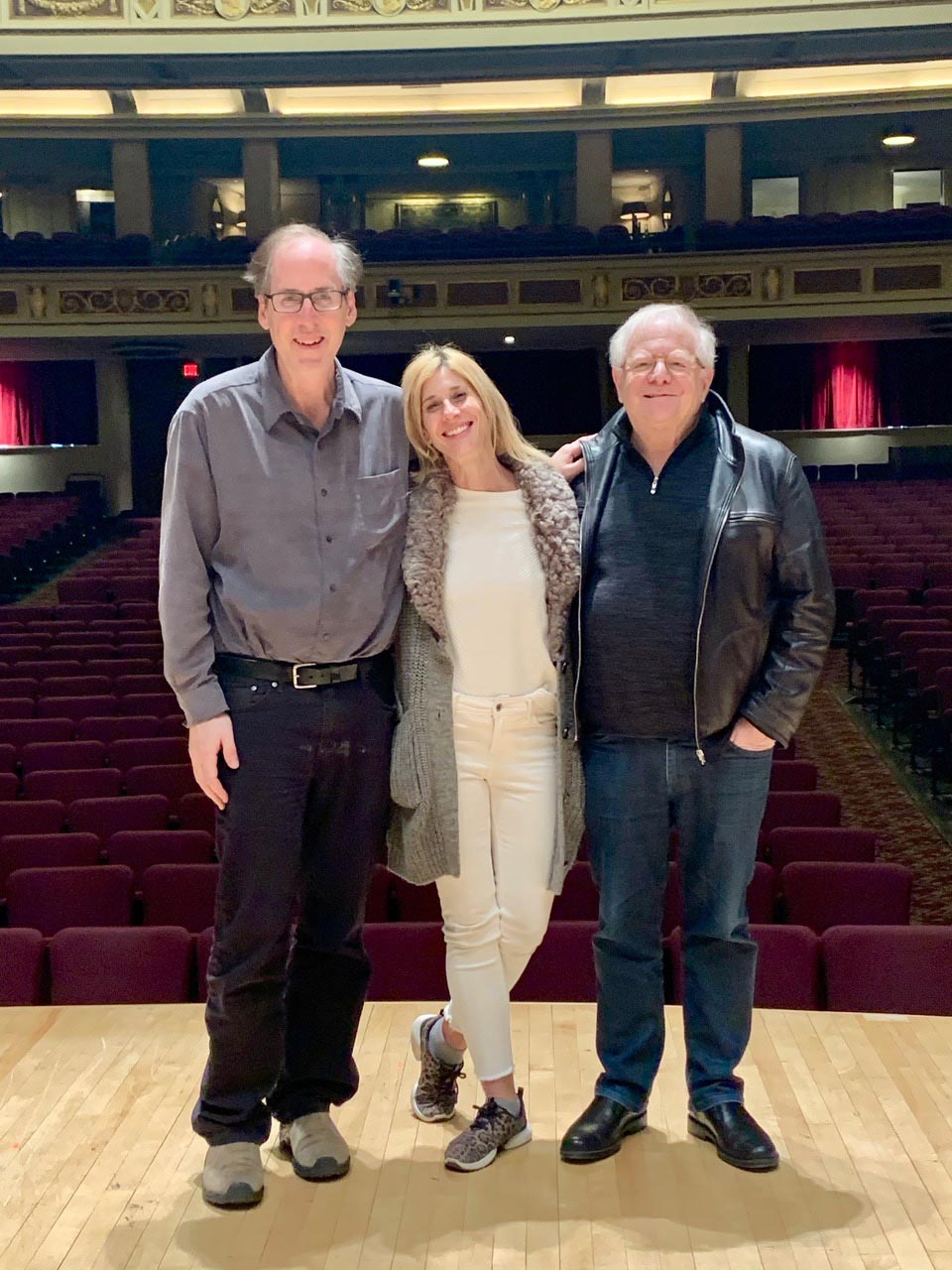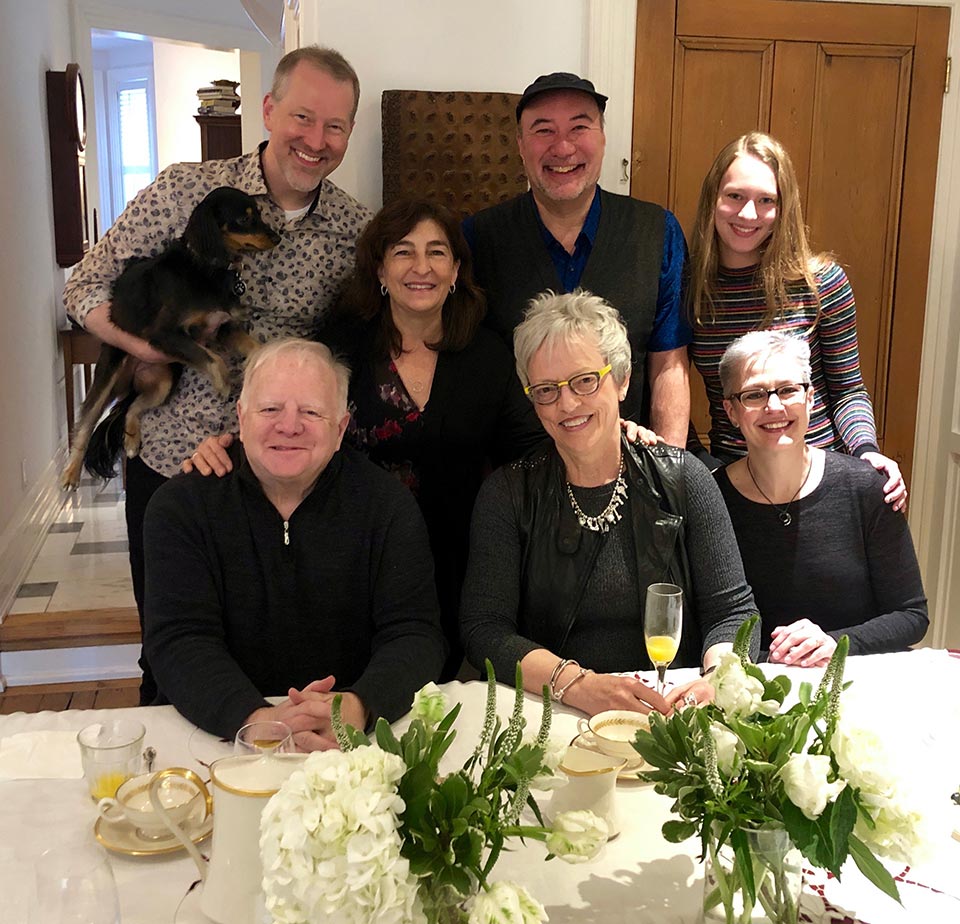There was a lot of meat, some stuffing and a bit of corn on the table. No, I am not talking about the Thanksgiving meal, but rather the musical buffet that made up the month of November.
One of the benefits of having more weeks available for guest conducting has been the opportunity to visit orchestras I have not conducted in quite a while. Buffalo, Rochester and Toronto filled that bill. Detroit was sandwiched in there, but now I return as the music director laureate, a job more like a guest conductor with a few additional administrative responsibilities.
Let’s start with the city that always pops up on the weather forecasts in the winter. It was 1978 when I last appeared in Buffalo. That was my only concert there, and at the time, it was memorable for the fact that I was there when I received three phone calls from orchestras inviting me to be their next music director. Back then, I learned, my program consisted of music by Verdi, Mozart and Sibelius. 41 years later, I got asked again.
Over the years, I have been in communication with the Buffalo Philharmonic’s music director, JoAnn Falletta. She invited me to return, and I was happy to accommodate. The program was a world away from the one other appearance. Pieces by McTee, Grieg and Elgar comprised this concert, and I was quite impressed with the quality of the orchestra. Very little of the city stuck in my memory the first time around, so Cindy and I took this opportunity to visit the American side of Niagara Falls.
It was a cold, blustery day, with rain and wind in abundance. Perhaps it was just as well, as this seemed to keep most of the tourists away, and we could experience the majesty and power of the cascade to its full advantage. Talk about feeling defenseless—when it comes to Mother Nature, we mortals cannot compete. Because I have to get visas for visits to Russia, Japan, and South Korea later this season, my passport was being circulated through various embassies. This prevented us from going to the Canadian side, which purportedly is even more spectacular.
“But wait,” you say. “You are going to Toronto on this trip. How will you get into the country?”
More on that a bit later.
Kleinhans Music Hall, where the Philharmonic performs, is almost 80 years old. As with many venues of the time, it seats about 2,500, and by today’s metrics is a bit large. However, the acoustics are excellent, and the projection of the sound to the audience seems good. With the varied program, we needed as much sonic variety as possible. Cindy’s Circuits opened the show and had its usual sense of fun and energy.
George Li was the soloist in the Grieg Concerto. He had an excellent, lyrical way with the piece, not trying to show off in the flashy parts. Elgar’s First Symphony rounded out the program. Most orchestras outside of the UK don’t have this in their repertoire, so for many of the musicians, it was the first time encountering this masterpiece. They threw themselves into the myriad challenges and produced a terrific account of the work. The audience, good sized on the first night, a bit less so for the Sunday afternoon show, appreciated all the hard work and rewarded the orchestra with a standing ovation.
Now I digress a little. There has been a lot of discussion in the press and on several websites as to what kind of programming orchestras should be doing to bring audiences into the halls as administrators struggle to find a balance between catering to traditional concertgoers and attracting younger patrons. While I was in Buffalo, I read a review in the New York Times in which the critic lamented that a guest conductor with the NY Phil had performed a program consisting of all mainstream works.
Meanwhile, in Buffalo, my program was advertised as “Leonard Slatkin Conducts Grieg.” Leaving aside the point that the conductor is not the main character in the Grieg Piano Concerto, the attraction for the audience seemed to be the once-familiar showcase for a pianist. The Grieg still is a wonderful piece, but it pales against the Elgar Symphony we performed. Over at the Philharmonic, I wondered what the size of the audience was for the standard fare versus programs in which the new and unfamiliar are the main events. It would seem that the cries for innovative programming are still only being heard in a few cities.
More importantly, what about the audience members who are experiencing the masterpieces of old for the first time? Doesn’t that constitute some adventure? Most of you reading this will realize that these words are coming from someone who has often broken the mold of traditional programming. But in reality, that has mostly not been the case. I have tried to balance programs by combining traditional with unorthodox works. You may see a few examples in the concerts I conducted this past month.
This subject will be one of the focuses not only of the book I am writing in collaboration with Robert Freeman, but also another one that I have begun taking notes for that will be a companion to my other publications. At this point, I have no idea when either will be completed or released to the public, but you will be kept informed and perhaps even get a glimpse into a chapter or two.
Staying in New York State, we ventured over to Rochester, only an hour’s drive from Buffalo. My only experience with the city was when I got an honorary doctorate from the Eastman School of Music and conducted the orchestra in music by Schwantner and Mahler. That was back in 1994, and Robert Freeman was the director of the school. As with many of my generation, I knew about the city through the recordings of Howard Hanson and Frederick Fennell. And we were always confused about the difference between the ensembles of the school and the Rochester Philharmonic. I had the opportunity to experience both on this trip.
The date came about because one of the other things I am doing in this post-music-director time is to go to a few different music schools and conservatories to get an idea of where things stand for the American instrumental music scene’s future. But it was also a chance to honor a person who has become a very good friend and a mentor to my son: Jeff Beal. His prolific output is truly astonishing. As a graduate of the Eastman School, he has now turned into one of its benefactors, along with his wife, Joan. The two of them even showed me the exact spot where they met when they were students.
When I had my coronary bypass surgery, I was holed up in my media cave for quite a while. Among the treasures I found in the dust-gathering DVD collection was a set from 2006 entitled Nightmares and Dreamscapes. This was a one-season anthology series based on short stories by Stephen King. I could not remember why I had purchased it, although I admit to being a Kingophile, so I popped the first disc into the player.
The title music struck me right away as being sort of tongue-in-cheek writing with a bit of edge, and I discovered that the composer was none other than the talented Jeff Beal. The first episode, “Battleground,” is about a hitman who, after completing an assignment, is confronted by a troop of toy soldiers, complete with tanks and missiles. About 15 minutes into the show, I realized that no one had said a word—sound effects and music made up the whole thing.
When the episode was over, I wrote to Jeff and begged him to make this a score that could be played live with the film. He did it, and so we presented it with the Eastman Philharmonic. In addition, we performed Jeff’s overture to the movie Pollock, as well as his song cycle The Paper Lined Shack. I had led the premiere performances of the latter in St. Louis last season with the always-incredible Hila Plitmann, who once again served as soloist. This performance was recorded for commercial release next year.
The orchestra was sensational throughout, rivaling anything one could have expected from a professional ensemble. The “Battleground” score is challenging, with nonstop playing for an hour and plenty of notes at top speed. In particular, the two pianists, placed near the front of the stage, and the percussion section, utilizing almost every instrument on the planet, were terrific. I hope to do this media work again, as it is quite satisfying on every level.
There were also several opportunities to speak with faculty and students. Young musicians in the various classes I attended showed a keen awareness of the difficulties they will face when they graduate and enter the highly competitive world of music. Robert Freeman returned to the school that he presided over for more than two decades and participated in several of the seminars. The new dean, Jamal Rossi, has had his hands full with a controversy over taking the orchestra to China. In the end, he correctly canceled the trip, as three South Korean musicians would not be allowed entry. This was an example of “truth to power” in action.
We had a day off before heading to Detroit, so Cindy and I took the opportunity to attend a concert by the Rochester Philharmonic. Its music director, Ward Stare, has been a friend and even played trombone in the orchestra of the Chicago Lyric Opera when I conducted there a few times. He has done a great job with his ensemble, and on this occasion led a particularly tricky program, not just for the orchestra but for the audience as well. Music by Bach—arranged by Webern, Schoenberg, Berg and Bartók—put everyone through their paces. Tessa Lark was the angel in Berg’s Violin Concerto, and Ward provided an empathetic collaboration. Rochester is quite fortunate to have a lot going on for music lovers, and it is being done at the highest level.
Returning to Detroit is always a pleasure, even if unseasonable snow and ice make the short trek from the apartment across the street to Orchestra Hall perilous. It had been almost half a year since I had seen the orchestra, and there were some new faces in the group as well as on the staff. My former office is devoid of Slatkin memorabilia, which was moved to my archive at home, save for a couple of posters announcing my two books. Despite not having a music director, or perhaps because of that, the orchestra has stayed in excellent shape. Overall our program was not too difficult, but there was a big premiere to tackle.
Mohammed Fairouz came to my attention a few years ago when we premiered his cello concerto. Since there is a substantial Arab population in the Detroit Metro area, I thought it might be both provocative and productive to give the first performance of that work in a synagogue. For my 75th birthday, Momo, as his friends call him, wanted to write something to celebrate the occasion. The result was an almost-half-hour-long song cycle based on poems by W. H. Auden. Another Time dealt with matters of time, coming to a new land, sexuality, and longing. These were brilliantly delivered by the tenor Miles Mykkanen with a fistful of sustained high notes that he brought off sensationally. The work won high approval from the audience, and I was honored to have it as part of my three-quarters-of-a-century commemoration.
The Roman Carnival Overture started things off with the appropriate flair as Monica Fosnaugh delivered the eloquent English Horn solo with her musical and full-toned sound. Pictures at an Exhibition—the Ravel version with Slatkin emendations— wrapped up the three concerts. I have now pretty much settled on this way of doing the piece but will keep my eyes peeled and ears open for new versions as they appear. I will return in March, and there are several items of interest for my next visits to Motown.
One item of interest came up for me while preparing the performances of Pictures. With the impeachment stuff going on, we started to hear and see a different way of pronouncing and rendering the capital of Ukraine. This was the home of my father’s family, and I have even conducted in that city. But all of a sudden, it was Kyiv, and even natives of the country seem to have different ways of saying it. So I told the audience, “For these performances of Pictures at an Exhibition, we will be renaming the finale section ‘The Great Gate of Hamtramck,’” referencing a suburb of Detroit that is similarly difficult to pronounce.
Two movies climbed up my chart of favorites of the year. Pain and Glory is the semiautobiographical film by Pedro Almodóvar, tracing his journey with loving attention to detail, brilliant direction and stunning cinematography, as well as a very surprising ending. It will be fascinating to see how the race for the Oscars goes in the Foreign Language category, as it will have to contend with Parasite. Bong Joon Ho, the great Korean filmmaker, has created a memorable film, one that challenges stereotypes and turns the tables on how a seemingly traditional film plays out. I loved both and would gladly see them again.
The whole week was a delight. Seeing friends, making music with what some still call “my orchestra,” and sharing what we have all been doing was terrific fun. And for a change, I did not have to visit any doctors.
Since the next stop was Toronto, I suppose you want to know how I got into Canada. My executive assistant and representative, Leslie Karr, resides in Detroit, and has been busy planning the visa processing timeline for upcoming international travel. My passport needs multiple visas attached in a short timeframe, and to facilitate that, we had to get creative and apply for a second valid U.S. passport. This way, I can leave the country with one document while Leslie circulates the other among a few embassies. Of course, I knew that there was such a thing as people having two passports. However, I did not realize that both could be from the same country.
And so the trip to Toronto went without international incident. It has been my pleasure to visit the orchestra on several occasions, but the last time was almost nine years ago. This time around, they had asked for an all-American program featuring Canadian pianist Jon Kimura Parker. One of his specialties has been the Barber Concerto. It is truly satisfying to realize that I have now done this piece with several keyboard artists, both established pianists and newcomers. For me, it represents the pinnacle of works in this form by an American composer, and Jackie delivers it with such passion and nuance. This was a pure pleasure, and the orchestra was on top of the very difficult writing the composer put on paper for them.
Cindy was represented with Double Play, and I send out considerable kudos to the percussion section for nailing the complex instrument changes perfectly. In remarks to the audience, I said: “Since there is a lot of scrutiny of those in the States giving jobs to their relatives, it is in the interest of transparency that I tell you that Cindy is my wife.” I went on to say, “Since my father, son, and I are also composers, I try to do one of our works every week to keep the royalty stream within the family.”
Also on the program were the Candide Overture, Corigliano’s early piece Elegy, and An American in Paris. In thinking about what I wrote earlier regarding familiar versus not-so-well-known, this program probably fits the profile of both. It was exciting to conduct, and the audience certainly got a lot of variety. In the Gershwin, the orchestra quickly understood what I was trying to do to balance style with substance. It is always tricky, as overdoing it ruins the structural integrity of the piece. I usually tell those unfamiliar with the idiom to watch a couple Fred Astaire films, but lately I have realized that many young musicians have no idea of whom I am speaking.
There was a lovely brunch hosted by the orchestra’s executive director, Matthew Loden. I did not have much time to get out and about, but there were three terrific restaurants we dined in. Not really knowing that much about the Toronto scene, I will not list them, with the assumption that there are many more to be tasted and tested.
Following the Toronto date, we had a very brief visit to Albuquerque. My good friend Steve Ovitsky runs the Santa Fe Chamber Music Festival during the summer. He had asked if I would be part of an event in which various members of the arts community come to have dinner at one of the donor’s homes. Although it took a bit of time to get there coming from Toronto, the evening was lovely, and the guests were delightful. Most importantly, it helped raise money for an arts institution that has put its mark on the American music scene.
After four weeks on the road, it was time to get home to celebrate the Thanksgiving holiday. With just two more weeks of conducting ahead, it was also a time to chill for a few days. The first stop will be Washington, DC with a return to my old band, the NSO, but clearly to a city that has changed dramatically. It will be most interesting to hear what my friends have to say and what their predictions are for the coming year.
Speaking of predictions, what is yours for the Best Orchestral Performance GRAMMY award? I was delighted to find out that the Detroit Symphony Orchestra and I were nominated for our recording of Billy the Kid and Grohg on the Naxos label. I encourage you to take a listen and to read what the critics have to say about the recording.
I hope you have all had an excellent holiday and are looking forward to the ones coming up at the end of this month. Don’t forget that the ninth chapter in the Star Wars series is being released, marking the final one that will have a complete John Williams score. Talk about a legacy.
See you in 2020,
Leonard



